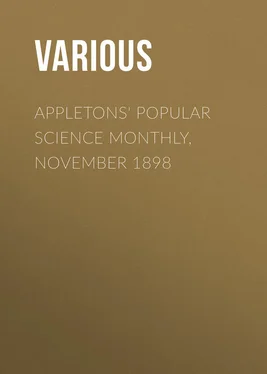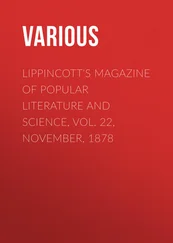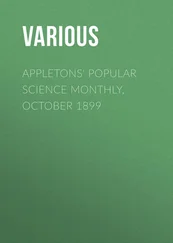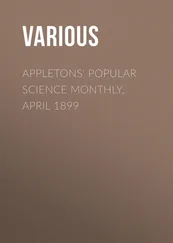Various - Appletons' Popular Science Monthly, November 1898
Здесь есть возможность читать онлайн «Various - Appletons' Popular Science Monthly, November 1898» — ознакомительный отрывок электронной книги совершенно бесплатно, а после прочтения отрывка купить полную версию. В некоторых случаях можно слушать аудио, скачать через торрент в формате fb2 и присутствует краткое содержание. Издательство: Иностранный паблик, Жанр: periodic, foreign_edu, на английском языке. Описание произведения, (предисловие) а так же отзывы посетителей доступны на портале библиотеки ЛибКат.
- Название:Appletons' Popular Science Monthly, November 1898
- Автор:
- Издательство:Иностранный паблик
- Жанр:
- Год:неизвестен
- ISBN:нет данных
- Рейтинг книги:5 / 5. Голосов: 1
-
Избранное:Добавить в избранное
- Отзывы:
-
Ваша оценка:
- 100
- 1
- 2
- 3
- 4
- 5
Appletons' Popular Science Monthly, November 1898: краткое содержание, описание и аннотация
Предлагаем к чтению аннотацию, описание, краткое содержание или предисловие (зависит от того, что написал сам автор книги «Appletons' Popular Science Monthly, November 1898»). Если вы не нашли необходимую информацию о книге — напишите в комментариях, мы постараемся отыскать её.
Appletons' Popular Science Monthly, November 1898 — читать онлайн ознакомительный отрывок
Ниже представлен текст книги, разбитый по страницам. Система сохранения места последней прочитанной страницы, позволяет с удобством читать онлайн бесплатно книгу «Appletons' Popular Science Monthly, November 1898», без необходимости каждый раз заново искать на чём Вы остановились. Поставьте закладку, и сможете в любой момент перейти на страницу, на которой закончили чтение.
Интервал:
Закладка:
The part the United States Government is taking in the work is to co-operate in experiments, to issue publications giving all desired information regarding culture, the machine question, and the utilization of the fiber. It tests new decorticators and reports to the public upon their merits or demerits. It cautions farmers and capitalists, for the present, to go into the industry with their eyes open, for the professional promoter has seized upon this industry, above all others in the fiber interest, as one in which he can more readily gull a gullible public. Nevertheless, responsible capitalists are making every legitimate effort to place the manufacturing industry on a solid basis in this country, and to attain to the progress made in other countries where manufacture has already been established, and where the Chinese fiber is employed as the raw material.
A Florida Sisal Hemp Plant.
Thus far I have only considered spinning fibers. More than one half of the raw fibers imported in the United States are employed in the manufacture of rope and small twine, or bagging for baling the cotton crop. Cordage is manufactured chiefly from the Manila and Sisal hemps, the former derived from the Philippine Islands, the latter from Yucatan. Some jute is also used in this industry, though the fiber is more largely employed in bagging; and some common hemp, such as is grown in Kentucky, is also used.
We can not produce Manila hemp in the United States, and this substance will always hold its own for marine cordage. Jute will grow to perfection in many of the Southern States, but it is doubtful if we can produce it at a price low enough to compete with the cheaper grades of the imported India fiber. Rough flax and common hemp might be used in lieu of jute, in bagging manufacture, but the question of competition is still a factor. Sisal hemp, which has been imported to the value of seven million dollars a year, when prices were high, will grow in southern Florida, and the plant has been the subject of exhaustive study and experiment. This plant was first grown in the United States on Indian Key, Florida, about 1836, a few plants having been introduced from Mexico by Dr. Henry Perrine, and from this early attempt at cultivation the species has spread over southern Florida, the remains of former small experimental tracts being found at many points, though uncared for.
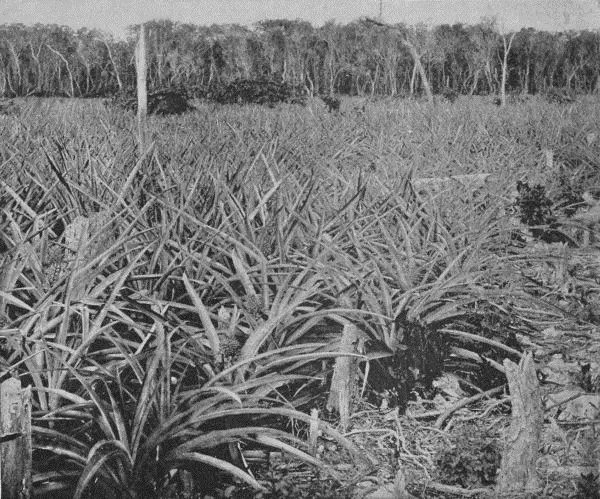
Pineapple Field in Florida.
The high prices of cordage fibers in 1890 and 1891, brought about by the schemes of certain cordage concerns, called attention to the necessity of producing, if possible, a portion of the supply of these hard fibers within our own borders. In 1891, in response to requests for definite information regarding the growth of the Sisal hemp plant, a preliminary survey of the Key system and Biscayne Bay region of southern Florida was made by the Department of Agriculture, and in the following year an experimental factory was established at Cocoanut Grove with special machinery sent down for the work. With this equipment, and with a fast-sailing yacht at the disposal of the special agent in charge of the experiments, a careful study of the Sisal hemp plant, its fiber, and the possibility of the industry was made, and the results were duly published. About this time the Bahaman Government became interested in the industry, and with shiploads of plants, both purchased and gathered without cost on the uninhabited Florida Keys, the Bahamans began the new industry by setting out extensive plantations on the different islands of the group. The high prices of 1890 having overstimulated production in Yucatan, two or three years later there was a tremendous fall in the market price of Sisal hemp, and Florida's interest in the new fiber subsided, though small plantations had been attempted. In the meantime, American invention having continued its efforts in the construction of cleaning devices, two successful machines for preparing the raw fiber have been produced which have, in a measure, superseded the clumsy raspadore hitherto universally employed for the purpose, and one of the obstacles to the production of the fiber in Florida is removed. The reaction toward better prices has already begun, and the future establishment of an American Sisal hemp industry in southern Florida is a possibility, though there are several practical questions yet to be settled.
Pineapple culture is already a flourishing industry in the Sisal hemp region. A pineapple plant matures but one apple in a season, and after the harvest of fruit the old leaves are of no further use to the plant, and may be removed. The leaves have the same structural system as the agaves – that is, they are composed of a cellular mass through which the fibers extend, and when the epidermis and pulpy matter are eliminated the residue is a soft, silklike filament, the value of which has long been recognized. Only fifty pounds of this fiber can be obtained from a ton of leaves, but, as the product would doubtless command double the price of Sisal hemp, its production would be profitable. How to secure this fiber cheaply is the problem. The Sisal hemp machines are too rough in action for so fine a fiber, and, at the rate of ten leaves to the pound, working up a ton of the material would mean the handling of over twenty thousand leaves to secure perhaps three dollars' worth of the commercial product. Were the fiber utilized in the arts, however, and its place established, it would compete in a measure with flax as a spinning fiber, for its filaments are divisible to the ten-thousandth of an inch. The substance has already been utilized to a slight extent in Eastern countries (being hand-prepared) in the manufacture of costly, filmy, cobweblike fabrics that will almost float in air.
Another possible fiber industry for Florida is the cultivation of bowstring hemp, or the fiber of a species of Sansevieria that grows in rank luxuriance throughout the subtropical region of the State. The fiber is finer and softer than Sisal hemp, though not so fine as pineapple fiber, and would command in price a figure between the two. The yield is about sixty pounds to the ton of leaves. Many other textile plants might be named that have been experimented with by the Government or through private enterprise, but the most important, in a commercial sense, have been named.
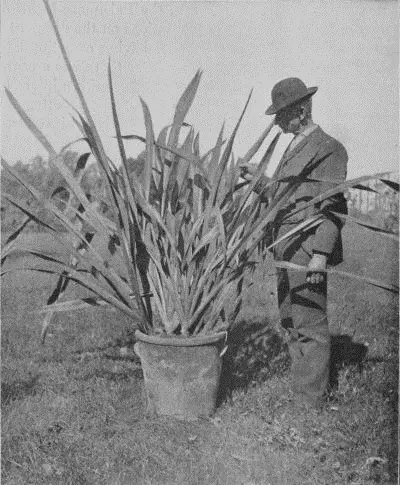
A Plant of New Zealand Flax.
There is a considerable list of plants, however, which are the subject of frequent inquiry, but which will never be utilized commercially as long as other more useful fibers hold the market. These for the most part produce bast fiber, and the farmer knows them as wild field growths or weeds. They are interesting in themselves, and many of them produce a fair quality of fiber, but to what extent they might be brought into cultivation, or how economically the raw material might be prepared, are questions the details of which only experiment can determine. But the fact that at best they can only be regarded as the substitutes for better, already established, commercial fibers has prevented serious experiment to ascertain their place. They are continually brought to notice, however, for again and again the thrifty farmer, as he finds their bleached and weather-beaten filaments clinging to the dead stalks in the fields, deludes himself in believing that he has made a discovery which may lead to untold wealth, and a letter and the specimen are promptly dispatched to the fiber expert for information concerning them. In such cases all that can be done is to give full information, taking care to let the inquirer down as easily as possible.
Читать дальшеИнтервал:
Закладка:
Похожие книги на «Appletons' Popular Science Monthly, November 1898»
Представляем Вашему вниманию похожие книги на «Appletons' Popular Science Monthly, November 1898» списком для выбора. Мы отобрали схожую по названию и смыслу литературу в надежде предоставить читателям больше вариантов отыскать новые, интересные, ещё непрочитанные произведения.
Обсуждение, отзывы о книге «Appletons' Popular Science Monthly, November 1898» и просто собственные мнения читателей. Оставьте ваши комментарии, напишите, что Вы думаете о произведении, его смысле или главных героях. Укажите что конкретно понравилось, а что нет, и почему Вы так считаете.
